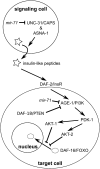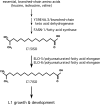To grow or not to grow: nutritional control of development during Caenorhabditis elegans L1 arrest
- PMID: 23824969
- PMCID: PMC3697962
- DOI: 10.1534/genetics.113.150847
To grow or not to grow: nutritional control of development during Caenorhabditis elegans L1 arrest
Abstract
It is widely appreciated that larvae of the nematode Caenorhabditis elegans arrest development by forming dauer larvae in response to multiple unfavorable environmental conditions. C. elegans larvae can also reversibly arrest development earlier, during the first larval stage (L1), in response to starvation. "L1 arrest" (also known as "L1 diapause") occurs without morphological modification but is accompanied by increased stress resistance. Caloric restriction and periodic fasting can extend adult lifespan, and developmental models are critical to understanding how the animal is buffered from fluctuations in nutrient availability, impacting lifespan. L1 arrest provides an opportunity to study nutritional control of development. Given its relevance to aging, diabetes, obesity and cancer, interest in L1 arrest is increasing, and signaling pathways and gene regulatory mechanisms controlling arrest and recovery have been characterized. Insulin-like signaling is a critical regulator, and it is modified by and acts through microRNAs. DAF-18/PTEN, AMP-activated kinase and fatty acid biosynthesis are also involved. The nervous system, epidermis, and intestine contribute systemically to regulation of arrest, but cell-autonomous signaling likely contributes to regulation in the germline. A relatively small number of genes affecting starvation survival during L1 arrest are known, and many of them also affect adult lifespan, reflecting a common genetic basis ripe for exploration. mRNA expression is well characterized during arrest, recovery, and normal L1 development, providing a metazoan model for nutritional control of gene expression. In particular, post-recruitment regulation of RNA polymerase II is under nutritional control, potentially contributing to a rapid and coordinated response to feeding. The phenomenology of L1 arrest will be reviewed, as well as regulation of developmental arrest and starvation survival by various signaling pathways and gene regulatory mechanisms.
Keywords: developmental arrest; diapause; insulin-like signaling; starvation; stress resistance.
Figures




References
-
- Abad P., Gouzy J., Aury J. M., Castagnone-Sereno P., Danchin E. G., et al. , 2008. Genome sequence of the metazoan plant-parasitic nematode Meloidogyne incognita. Nat. Biotechnol. 26: 909–915 - PubMed
-
- Albert P. S., Brown S. J., Riddle D. L., 1981. Sensory control of dauer larva formation in Caenorhabditis elegans. J. Comp. Neurol. 198: 435–451 - PubMed
-
- Angelo G., Van Gilst M. R., 2009. Starvation protects germline stem cells and extends reproductive longevity in C. elegans. Science 326: 954–958 - PubMed
Publication types
MeSH terms
Substances
LinkOut - more resources
Full Text Sources
Other Literature Sources
Research Materials
Miscellaneous

